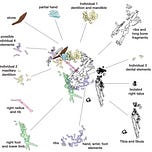Paleoanthropology is a field of constant surprises, where the oldest certainties can be upended by a single discovery. For decades, the story of human evolution was a tidy progression: Bigger brains meant greater intelligence, which in turn led to complex behaviors like creating art, using fire, and, most powerfully, engaging in mortuary rituals. This story placed us—Homo sapiens—at the pinnacle, with our ancient cousins like Neanderthals following close behind. But a small-brained hominin from a South African cave system has complicated this narrative in the most profound way.

For several years, the species known as Homo naledi has been at the center of one of the most intense debates in the study of human origins. The initial theory, popularized in a 2017 Netflix documentary, suggested that this species, with a brain no larger than a chimpanzee’s, had deliberately buried its dead. The claim was initially met with widespread skepticism among many independent experts. A significant criticism was that the remains could have simply been transported to their final resting place by natural forces, such as water flow. In science, extraordinary claims require extraordinary evidence.
Now, a new study in the journal eLife1 revisits the case, providing a detailed reanalysis of the evidence. The research, led by Lee Berger and an international team, offers a more robust argument for a complex suite of behaviors that include the deliberate burial of the dead. The findings, which have convinced at least one of the original skeptical peer reviewers, are forcing the field to reconsider the fundamental relationship between brain size and the origins of ritual and symbolic thought.
The Meticulous Taphonomy of a Burial
To understand the controversy, one must look closely at the geological and taphonomic evidence from the Rising Star Cave system. The skeletal remains of Homo naledi were found deep within the Dinaledi Subsystem, a network of chambers and passages so narrow and challenging to navigate that it requires specialized cavers to reach. This location alone suggests that bodies did not simply wash in or fall from a surface entrance.
The researchers focused on three distinct areas within the cave where concentrations of Homo naledi fossils were found: the Hill Antechamber Feature, the Dinaledi Chamber Feature 1, and the original "Puzzle Box" area. At each of these locations, the team meticulously studied the spatial arrangement of the bones and the composition of the surrounding sediment. Their analysis provided several lines of evidence that, when taken together, challenge the idea of natural accumulation.
Perhaps the most compelling evidence comes from the state of the bones themselves. The fossils were found in articulated or semi-articulated positions, a phenomenon the researchers call "matrix-supported skeletal regions." This means that the bones of an individual were still held together by soft tissue when they were rapidly covered by sediment. This finding directly contradicts the hypothesis that the bodies decomposed on an open cave floor before being slowly covered by sediment, as decomposition would have caused the joints to disarticulate and the bones to scatter.
The team's work also provides evidence that the remains were placed in pits that were intentionally dug. In the Hill Antechamber, the stratigraphic layers in the cave floor, which slope at a steep angle, are abruptly truncated at the edges of the fossil concentration. This pattern suggests that a hole was dug through the pre-existing layers before the body and new sediment were placed inside. Similarly, in the Dinaledi Chamber, a distinct layer of laminated orange silty-mudstone is interrupted by the feature containing the Homo naledi bones. This disruption is inconsistent with a natural depression and instead points to the deliberate excavation of a pit.
The newly published work presents a minimal definition of "cultural burial" consisting of three components:
A hole or pit is dug by hominins into the sediment.
A body or body parts are placed into this feature by hominins.
The remains are covered (backfilled) by hominins.
The evidence from the cave fits this definition. The new findings are so convincing that one of the anonymous peer reviewers, who had initially found the evidence for intentional burial "inadequate and unconvincing," reversed their position. n their revised manuscript, the authors have implemented substantial improvements in methodology, analytical depth, and overall presentation, which have effectively resolved the critical issues previously highlighted. Key gaps in the earlier version, such as the absence of detailed reconstructions of taphonomic processes, bone articulations, and displacement patterns, have been addressed with thorough analyses and clearer illustrations.
The reviewer also noted that the new data now includes evidence that the bones were placed in human-made pits, directly addressing a prior concern.
Rethinking the Hominin Mind
The implications of this study reach far beyond a single cave system. If Homo naledi buried its dead approximately 241,000 to 335,000 years ago, it means a species with an average brain size of just 550 cubic centimeters was capable of a behavior previously attributed only to larger-brained hominins like Neanderthals and modern humans. This challenges a long-standing paradigm in anthropology, which has often treated brain size as the primary driver of complex cognitive and cultural behaviors.
The question of why Homo naledi might have engaged in this behavior remains open. Did they possess a complex understanding of death or an emotional response akin to grief? The researchers are cautious about attributing modern human motivations to these ancient relatives, but they suggest that the behavior is a clear sign of an intentional and meaningful response to death.
The paper also highlights other intriguing findings. In the Hill Antechamber, the researchers found a stone object positioned near an articulated hand, embedded in the sediment at an angle that could not have occurred naturally. While the study does not definitively conclude that this was a "grave good" intentionally placed with the body, its distinctive placement is intriguing and suggests a degree of forethought. The team also documented a number of engravings on a nearby cave wall that have been attributed to Homo naledi, adding to the picture of a species with complex social and cognitive capabilities. These findings suggest that the emergence of complex social behaviors was not a single, linear event tied to one hominin lineage, but rather a more complex story of convergent evolution in different species with very different cognitive architectures.
As the study's authors note, the evidence forces us to confront an uncomfortable but necessary truth: the story of human evolution is not a simple, single path to our modern selves. It is a story of multiple hominin lineages, each with its own unique toolkit for making sense of their world and confronting the profound mystery of death.
Additional Research
Martinón-Torres, M., d'Errico, F., Santos, E., Álvaro Gallo, A., Amano, N., Archer, W., Armitage, S. J., Arsuaga, J. L., Bermúdez de Castro, J. M., Blinkhorn, J., Crowther, A., Douka, K., Dubernet, S., Faulkner, P., Fernández-Colón, P., Kourampas, N., González García, J., Larreina, D., Le Bourdonnec, F.-X., MacLeod, G.,... & Lari, M. (2021). Earliest known human burial in Africa. Nature, 593(7857), 95-100. DOI: 10.1038/s41586-021-03457-8. This study documents the oldest known Homo sapiens burial in Africa, a child found in a deliberately excavated pit in a cave in Kenya, dating to approximately 78,000 years ago.
Pomeroy, E., Bennett, P., Hunt, C. O., Reynolds, T., Farr, L., Frouin, M., Holman, J., Lane, R., French, C., & Barker, G. (2020). New Neanderthal remains associated with the 'flower burial' at Shanidar Cave. Antiquity, 94(373), 11-26. DOI: 10.15184/aqy.2019.207. This research describes a new adult Neanderthal skeleton found at the famous Shanidar Cave in Iraq, showing articulated remains within a stratigraphic context that suggests intentional burial.
Sala, N., Pantoja-Pérez, A., Gracia, A., & Arsuaga, J. L. (2024). Taphonomic-forensic analysis of the hominin skulls from the Sima de los Huesos. The Anatomical Record, 307(9), 2259-2277. DOI: 10.1002/ar.24883. This paper explores the taphonomy of the thousands of hominin fossils from the Sima de los Huesos site in Spain, concluding that the accumulation of bodies was not due to a natural accident, but rather intentional disposal of corpses, predating the Homo naledi burials by hundreds of thousands of years.
Berger, L. R., Makhubela, T. V., Molopyane, K., Krüger, A., Randolph-Quinney, P., Elliott, M., Peixotto, B., Fuentes, A., Tafforeau, P., Beyrand, V., Dollman, K., Jinnah, Z., Brewer Gillham, A., Broad, K., Brophy, J., Chinamatira, G., Dirks, P. H., Feuerriegel, E., Gurtov, A., … Hawks, J. (2025). Evidence for deliberate burial of the dead by Homo naledi. eLife, 12(RP89106). https://doi.org/10.7554/elife.89106.3









